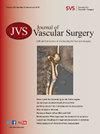血管外科研究中的性别报告与分析。
IF 3.9
2区 医学
Q1 PERIPHERAL VASCULAR DISEASE
引用次数: 0
摘要
目的通过量化影响力大的血管外科期刊中基于性别的数据的收录和分析,研究人类血管外科研究中的性别问题:对 2018 年 1 月 1 日至 2020 年 12 月 31 日和 2023 年 1 月 1 日至 2023 年 12 月 31 日发表在《欧洲血管和血管内外科杂志》、《血管外科杂志》、《JVS:静脉和淋巴疾病》、《血管内治疗杂志》和《血管外科年鉴》上的原稿进行了文献综述。摘录的数据包括基于性别的数据分析、将性别作为变量纳入多变量分析、将性别作为自变量纳入多变量分析以及基于性别结果的讨论:在 3,762 篇包含人类、动物或细胞受试者的文章中,有 249 篇(6.6%)没有说明性别。在这 249 篇文章中,183 篇包含人类受试者,55 篇包含动物受试者,11 篇使用细胞系作为受试者。这些文章以及其余 68 篇以动物为研究对象的文章均已从分析中删除。此外,有 23 篇文章研究了性别特异性病理学,也从分析中删除。在本研究收录的其余 3422 篇文章中,42.3% 的文章对性别进行了分析,46.9% 的文章将性别纳入多变量分析,4.8% 的文章将性别作为自变量,26.6% 的文章对性别进行了讨论。2018 年、2019 年和 2020 年之间,四个性别变量均无明显差异。在 2018-2020 年和 2023 年之间,所有四个性别变量都有显著增加。多中心研究的性别独立分析率明显高于单中心研究(7.4% vs 3.3%,P 结论:多中心研究的性别独立分析率明显高于单中心研究(7.4% vs 3.3%,P 结论:多中心研究的性别独立分析率明显高于单中心研究:在血管外科研究中,公平纳入和分析性别变量的情况很少见。只有不到5%的文章对数据进行了独立的性别分析,很少有研究对男性和女性进行了平等的纳入。临床研究是循证医学的基础;因此,必须努力实现数据的公平纳入、分析和报告,以促进临床研究对男性和女性的普适性。本文章由计算机程序翻译,如有差异,请以英文原文为准。
Reporting and analysis of sex in vascular surgery research
Objective
To examine sex in human vascular surgery research by quantifying the inclusion and analysis of sex-based data in high-impact vascular surgery journals.
Methods
A bibliographic review of original articles published in the European Journal of Vascular and Endovascular Surgery, Journal of Vascular Surgery, JVS: Venous and Lymphatic Disorders, Journal of Endovascular Therapy, and Annals of Vascular Surgery from January 1, 2018, to December 31, 2020, and from January 1, 2023, to December 31, 2023, was conducted. Abstracted data included sex-based data analysis, inclusion of sex as a variable in multivariable analysis, inclusion of sex as an independent variable, and a discussion of sex-based results.
Results
Of the 3762 articles that included human, animal, or cell subjects, 249 (6.6%) did not state sex. Of those 249 articles, 183 included human subjects, 55 included animal subjects, and 11 used cell lines as the subjects. These were removed from analysis as well as the remaining 68 articles with animal subjects. In addition, 23 researched a sex-specific pathology and were removed from analysis. Of the remaining 3422 articles included in our study, 42.3% analyzed sex, 46.9% included sex in multivariable analysis, 4.8% included sex as an independent variable, and 26.6% included a discussion of sex. There were no significant differences in all four sex variables between 2018, 2019, and 2020. Between 2018-2020 and 2023, there were significant increases in all four sex variables. Multicenter studies had significantly higher rates of independent analysis of sex over single-center studies (7.4% vs 3.3%, P < .001). There was no significant difference in independent analysis of sex between U.S.-based and non-U.S.-based studies. Only 191 articles (5.6%) had 90% or greater matching of men and women in their study.
Conclusions
Equitable inclusion and analysis of sex is rare in vascular surgery research. Less than 5% of articles included an independent analysis of data by sex, and few studies included males and females equally. Clinical research is the basis for evidence-based medicine; therefore, it is important to strive for equitable inclusion, analysis, and reporting of data to foster generalizability of clinical research to men and women.
求助全文
通过发布文献求助,成功后即可免费获取论文全文。
去求助
来源期刊
CiteScore
7.70
自引率
18.60%
发文量
1469
审稿时长
54 days
期刊介绍:
Journal of Vascular Surgery ® aims to be the premier international journal of medical, endovascular and surgical care of vascular diseases. It is dedicated to the science and art of vascular surgery and aims to improve the management of patients with vascular diseases by publishing relevant papers that report important medical advances, test new hypotheses, and address current controversies. To acheive this goal, the Journal will publish original clinical and laboratory studies, and reports and papers that comment on the social, economic, ethical, legal, and political factors, which relate to these aims. As the official publication of The Society for Vascular Surgery, the Journal will publish, after peer review, selected papers presented at the annual meeting of this organization and affiliated vascular societies, as well as original articles from members and non-members.

 求助内容:
求助内容: 应助结果提醒方式:
应助结果提醒方式:


